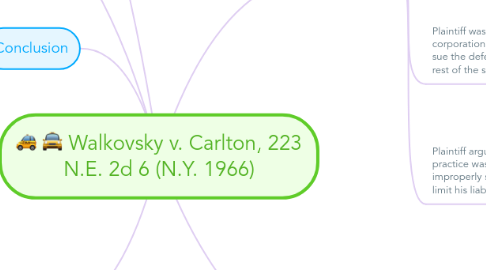
1. Conclusion
1.1. The complaint was dismissed since in New York, a stockholder is not personally liable for torts of his corporation unless it is shown that was conducting business in his own capacity. The question of whether the corporation was adequately capitalized, the court ruled that it depends on the circumstance around it.
1.1.1. The court found that the Defendant (Carlton) was not personally liable based on the grounds that no evidence of fraud was found, it was NOT undercapitalized, and the business was run legitamately
2. Application
2.1. Undercapitalization refers to a corporation NOT given enough assets to conduct its business dutifully
2.1.1. This would allow it to limit the liability if someone made a claim against it
2.2. Court found that the Defendant's nine other corporations were not relevant since the specific corporation that hit the Plaintiff was legitimate and NOT undercapitalized
2.2.1. As a result, there was no basis for the court to Pierce the Corporate Veil
2.3. Court also found that Plaintiff's complaint did not allege fraud on the Defendant's side
2.4. It was highlighted and inferred that because the corporation was only carrying $10,000 for insurance, the defendant was holding out for his own personal capital gain
2.4.1. While the bare minimum approach was taken, it was agreed that the legislation is what is at fault if $10000 as the minimum is not a adequate amount
3. Why business professionals care
3.1. As was stated in the case, many taxi service corporations, in addition to other corporations often times will structure their enterprise in a similar manner to hedge liability risks. Mirroring their approach to that of the defendant could help to insure that they can not be held liable in the future
4. Impact of the decision
4.1. Gartner v. Snyder 607 F.2d 582 (2d Cir. 1979)
4.2. United States v. O'Connell 496 F.2d 1329 (2d Cir. 1974)
4.3. State of N.Y. v. Shore Realty Corp 759 F.2d 1032 (2d Cir. 1985)
5. Facts
5.1. Defendant (Carlton) owned a fleet of 20 taxicabs all of which fell under a set of 10 separately listed corporations
5.1.1. This is a common practice in the taxi industry where ownership of the fleet is vested in many corporations each owning one or two cabs.
5.1.2. Each corporation held the absolute minimum liability insurance of $10,000
5.2. The plaintiff was hit by a cab and severely injured in NYC in 1962. The cab was owned by Seon Cab Corporation and operated by the individual defendant Carlton who was a stakeholder of 10 corporations including Seon.
5.2.1. The defendant had two cabs registered in his name. Under the law, the minimum automobile liability insurance is $10,000 for each cab.
5.2.1.1. One of the defendant's cabs hit the plaintiff (Walkovszky)
5.2.1.1.1. Plaintiff sued but because he could only sue one of the ten corporations with $10,000 liability insurance, he wanted hold all stakeholders personally liable for the damages. $10,000 mandatory insurance was insufficient to assure recovery of the plaintiff, so he sought to hold the defendant personally liable.
5.3. Plaintiff was unable to get money from the corporation and asked the court to allow him to sue the defendant directly, in addition to the rest of the separately listed corporations
5.3.1. Courts use the terminology 'piece the corporate veil' whenever necessary to prevent fraud or achieve equity. This is to hold individuals liable who use the corporation to achieve their own business rather than the corporation.
5.3.1.1. Based on this reasoning, the plaintiff asked court to Pierce the Corporate Veil in order to sue the Defendant directly arguing that he was injured as a result negligent operations of a cab that was owned and operated by one of the four corporations affiliated with the defendant terminal.
5.3.1.1.1. The plaintiff further argued that the name was displayed on both sides of the taxis used in the enterprise and the defendant serviced, inspected, repaired, and dispatched them.
5.3.2. The defendant argued that suing him individually rather than the corporation 'fails to state a cause of action.'
5.4. Plaintiff argued that Defendant's business practice was fraudulent because he was improperly sequestering assets to artificially limit his liability
5.4.1. If there existed one corporation for all 20 cabs then the Plaintiff could sue for all of the assets to cover his injuries
6. Rule
6.1. The issue before the court was whether the defendant should be held personally liable for the injuries suffered by the plaintiff because he organized, managed, dominated, and controlled a fragmented corporate entity which merely provided cover to carry out his business without imposing financial or other liabilities.
6.1.1. The question before the court was; 'did the plaintiff conduct business in his individual capacity?'
6.1.1.1. The plaintiff had a burden to prove that the defendant was personally liable, that is, personal liability of the corporation's stockholders since the ownership of the fleet had been deliberately split up among many corporations.
6.1.1.1.1. The law (section 370 of the Vehicle and Traffic Law) allowed taxi owner-operators to form fleets with different corporations. The law also stated the minimum insurance required by subdivision which the defendant had paid.
6.1.2. The court stated that it is not impossible for the plaintiff to state the valid cause of action again the defendant but the plaintiff had not done so. The court also added that the separate corporations were not undercapitalized as alleged.
6.1.2.1. The court noted that if the insurance coverage was not adequate to protect the public, the remedy lies with the legislature not the courts.
